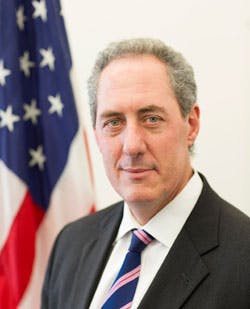Currently under negotiation is a complex international trade pact called the Trans-Pacific Partnership, commonly known as the TPP. The U.S. is engaged in discussions with 11 other nations – Australia, Brunei, Canada, Chile, Japan, Malaysia, Mexico, New Zealand, Peru, Singapore and Vietnam.
The “free trade” measure has generated controversy, drawing opposition from certain organizations in the U.S., such as Public Citizen, which contends that it would “offshore jobs to low-wage countries” while other provisions “would impose limits on government policies that we rely on in our daily lives for safe food, a clean environment and more. Our domestic federal, state and local policies would be required to comply with TPP rules.”
Late last year in a press briefing Froman reported on “parallel talks” with Japan related to the auto industry. “It’s parallel for now,” says Froman, “but parts of it will become integrated into the agreement at the end of the day. And that’s a focus, on autos to open up Japan’s auto market, to deal with a number of the historical issues that have prevented the penetration of that market by U.S. auto companies, and also to deal with other non-tariff measures that keep out U.S. exports so that we can expand those exports and support jobs here at home.”
While negotiations among the participating nations remain ongoing, and a timetable for a formal agreement remains uncertain, Froman has prepared a series of questions and answers regarding the TPP’s status thus far:
Q: What is the Trans-Pacific Partnership?
A: The Trans-Pacific Partnership is a vehicle for Asia-Pacific-wide economic integration, which will strengthen U.S. ties to the robust economies of this region. The initiative starts with an economically significant group of countries that share our vision of negotiating a high-standard, 21st century regional agreement. The goal is to include additional Asia-Pacific countries in successive clusters to eventually cover a region that represents more than half of global output and over 40 percent of world trade.
Q: Why is the United States participating in the TPP?
A: The United States has decided to participate in the TPP because it is the best vehicle for the United States to advance our economic interests in the critical Asia-Pacific region. Expanding U.S. exports is critical to our economic recovery and to the creation and retention of high-quality jobs in the United States. With its rapid growth and large markets, there is no region with which expanding our trade is more vital than the Asia-Pacific.
Q: What does the Administration mean when it says it wants to negotiate a “21st century” trade agreement?
A: The Administration recognizes that the concerns that workers, businesses, farmers and ranchers have today are different than those they had a generation ago. We intend to negotiate a high-standard, regional agreement that addresses new and emerging issues, incorporates new elements reflecting our values and priorities and responds to the 21st century challenges our citizens face.
Our goal is to develop an agreement that creates and retains U.S. jobs, including by promoting innovation and competitiveness, encouraging new technologies and emerging economic sectors, increasing the participation of small- and medium-sized businesses in trade, supporting the development of efficient production and supply chains that include U.S. firms in order to encourage firms to invest and produce in the United States, and promoting regulatory coherence and cooperation among the TPP members. We also are seeking to work with our TPP partners on other trade-related priorities, such as development, transparency, workers rights and protections, environmental protection and conservation and other issues.
Q: How are you reaching out to the public to ensure you receive the input you need?
A: The Administration is committed to working in close partnership with Congress and stakeholders as it develops negotiating objectives for the TPP. We published a Federal Register Notice on Dec. 16 seeking comments to help the U.S. Government develop its negotiating objectives for the TPP. The U.S. Government received 129 detailed comments from business associations, NGOs (Non-Governmental Organizations), individual companies and other groups, which we are reviewing carefully. We also are studying comments we received from members of Congress. In addition, we have launched a 50-state outreach plan seeking comments from stakeholders around the country on issues of concern to them.
We would welcome any additional questions or comments at www.ustr.gov.
Q: What other countries are involved in the TPP?
A: The current (formal) members are Singapore, Chile, New Zealand, Brunei, Australia, Peru and Vietnam.
Q: Are other Asia-Pacific countries also considering participation in the TPP?
A: Several other countries are actively considering joining. The TPP members welcome that interest and have established a process to facilitate the addition of new members going forward.
Q: What is the expected timeline for negotiations/completion?
A: The TPP members seek to complete negotiations as expeditiously as possible, recognizing that all members share a high level of ambition for this agreement.
Subscribe to Aftermarket Business World and receive articles like this every month….absolutely free. Click here.


